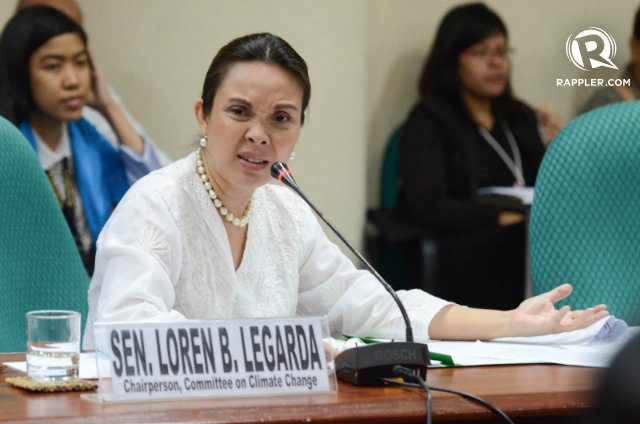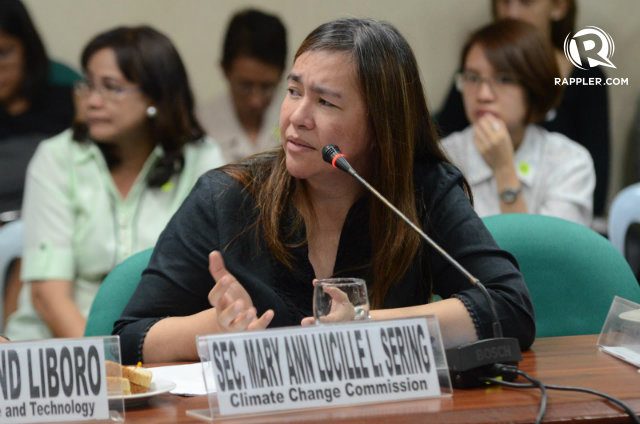SUMMARY
This is AI generated summarization, which may have errors. For context, always refer to the full article.

MANILA, Philippines – “Detached from human reality.”
This was how Senator Loren Legarda described certain government agencies that gave permits to new coal plants, despite well-established information that coal produces carbon dioxide, which worsens climate change.
“The worst source of carbon is coal. So why did we approve 21 coal power plant ECCs (Environmental Compliance Certificate)? This scenario scares me,” Legarda said during a Senate hearing on climate change on Tuesday, June 9.
Global warming is primarily caused by the rapid increase in carbon dioxide (CO2) emissions, mostly resulting from human activities like deforestation and the burning of fossil fuels like coal. (READ: Climate change boosts conflict risk, flood, hunger: UN)
Carbon dioxide is now at unprecedented levels, unseen for at least the last 800,000 years, according to the Intergovernmental Panel on Climate Change (IPCC). In fact, 9 of the 10 warmest years in the last 134 years have occurred since 2000.
“When I realized our own government could approve additional coal plants, it scares me further. It seems that there are certain government agencies detached from human reality,” the senator said.
Undersecretary Jonas Leones of the Department of Environment and Natural Resources (DENR), however, said that the issuance of ECCs does not guarantee coal power plants can operate.
“ECCs are a set of conditions wherein the proponents comply with environmental mitigations and enhancement,” Leones explained. He said the DENR issued ECCs to support the thrust of the Department of Energy (DOE).
Before ECCs are issued, the power plants should first have an “operating agreement with DOE,” Leones said, adding that consultations with local government units (LGUs) and communities must be made.
“Then the proponents are required to make an environmental impact statement,” Leones said. “If it’s an IP (indigenous people) or protected area, we consult the Biodiversity Management Bureau.”
Coal power plants

In the past two years, the Philippine government has appoved 21 coal power projects, but only two are operational.
|
Operational coal powerplants Source: DENR |
||
| Proponent | Location | Date of ECC issued |
| Toledo Power Expansion | Cebu | Aug 2012 |
| Pagbilao Team Energy Corporation | Quezon Province | Feb 2014 |
“It’s like there’s a race to build coal plants in two years,” Legarda quipped.
Legarda said she was unaware of how ECCs were granted.
“As far as coal plants are concerned, the DOE actually remains technology-neutral. What we need are stable, reliable, and affordable energy or electricity to be provided to the people,” said Energy Undersecretary Raul Aguilos.
“As far as application of coal power plants are concerned, yes, we endorse this because we need to improve and increase the capacity, especially for problematic areas like Mindanao, where massive brownouts occurred because they’re so dependent on hydroelectric power plants,” Ariaso explained.
He added that since the Philippines is now in a “privatized environment, the government cannot invest in power generation, so we leave it to the private sector to decide.”
Among all technologies available, coal is the cheapest, he said.
Legarda, however, argued that although coal may be the most affordable in terms of business, its adverse health and environmental impacts are far from cheap.
At present, the country’s power mix is 40% coal. Without intervention, it could increase to 70% by 2030, Aguilos said. “That’s why there’s a need for us to work with the Climate Change Commission and other agencies.”
Degrees

The United Nations Framework Convention on Climate Change of 1992 was ratified by 196 countries agreeing to keep the average global temperature rise below 2°C.
The Philippines was one of its signatories, yet it continues to use coal as one of its energy sources.
The Philippines, as the new chair of the Climate Vulnerable Forum (CVF), is also pushing for a 1.5°C reference, said Secretary Lucille Sering of the Climate Change Commission.
What’s so crucial about 1.5°C? The number seems small, but its impacts are huge. (INFOGRAPHIC: Climate change)
“Even with one degree centigrade, there would be rising intensity of storms,” said Rosalina de Guzman of state weather bureau PAGASA. A 1°C increase could also mean at least 10% reduction in yield, and at 2°C, changes are “irreversible.”
This could also damage roughly a third of coral reefs, added Dr Gemma Narisma of the Manila Observatory, leaving over 500 million people affected by job loss, food insecurity, and hunger.
Meanwhile, an increase of 4°C or more could result in lower agricultural production, ecosystem losses, and reduction in animal and plant species.
“GDP growth is almost the same as the carbon dioxide growth in any country,” Sering observed, hence the challenge for governments to balance improving the economy while also saving the environment.
Both developed and developing countries, she stressed, should commit to reducing carbon emissions.
“Maraming magsasabing ‘di naman tayo [carbon] emitter, ‘di naman tayo makakatuldok sa mundo, so bakit pa tayo magko-comply?” said Legarda. (A lot of people say we’re not emitters, we won’t put an end to global warming, so why do we need to comply?)
“But it makes good business sense, environment sense, health sense to mitigate,” she added. – Rappler.com
Coal power plant image from Shutterstock
Add a comment
How does this make you feel?
There are no comments yet. Add your comment to start the conversation.